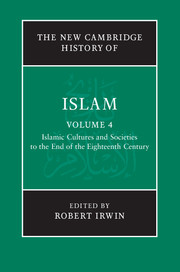Book contents
- Frontmatter
- Introduction
- PART I RELIGION AND LAW
- PART II SOCIETIES, POLITICS AND ECONOMICS
- 7 Legitimacy and political organisation: caliphs, kings and regimes
- 8 The city and the nomad
- 9 Rural life and economy until 1800
- 10 Demography and migration
- 11 The mechanisms of commerce
- 12 Women, gender and sexuality
- PART III LITERATURE
- PART IV LEARNING, ARTS AND CULTURE
- Glossary
- Bibliography
- Index
- References
10 - Demography and migration
from PART II - SOCIETIES, POLITICS AND ECONOMICS
Published online by Cambridge University Press: 28 March 2011
- Frontmatter
- Introduction
- PART I RELIGION AND LAW
- PART II SOCIETIES, POLITICS AND ECONOMICS
- 7 Legitimacy and political organisation: caliphs, kings and regimes
- 8 The city and the nomad
- 9 Rural life and economy until 1800
- 10 Demography and migration
- 11 The mechanisms of commerce
- 12 Women, gender and sexuality
- PART III LITERATURE
- PART IV LEARNING, ARTS AND CULTURE
- Glossary
- Bibliography
- Index
- References
Summary
Estimating medieval population figures
A number of suggestions have been made for estimating urban populations for periods from which no direct data are extant, some being more convincing than others. Thus it is problematic to assume that the floor space of a given city’s principal mosque indicates the size of the relevant settlement, or at least of its adult male population, unless a written source tells us that such a relationship did in fact exist. Patrons may well have financed a huge building due to considerations of ‘magnificence’ or political rivalry, or else they may have wished to provide for villagers who came to the city on market days and attended communal prayers on this occasion. None of these considerations was connected to the actual number of inhabitants. Another measure of pre-modern urban populations, namely the quantities of grain needed to feed a given city, can only convey a very rough notion: rich people may have fed grain to their animals, thus augmenting the demand, or else others may have had supplementary sources of food in their gardens and thus needed less than the statistical minimum of grain required to keep body and soul together. But even so, where information on grain consumption is available it does provide an idea of urban population size.
- Type
- Chapter
- Information
- The New Cambridge History of Islam , pp. 306 - 331Publisher: Cambridge University PressPrint publication year: 2010

